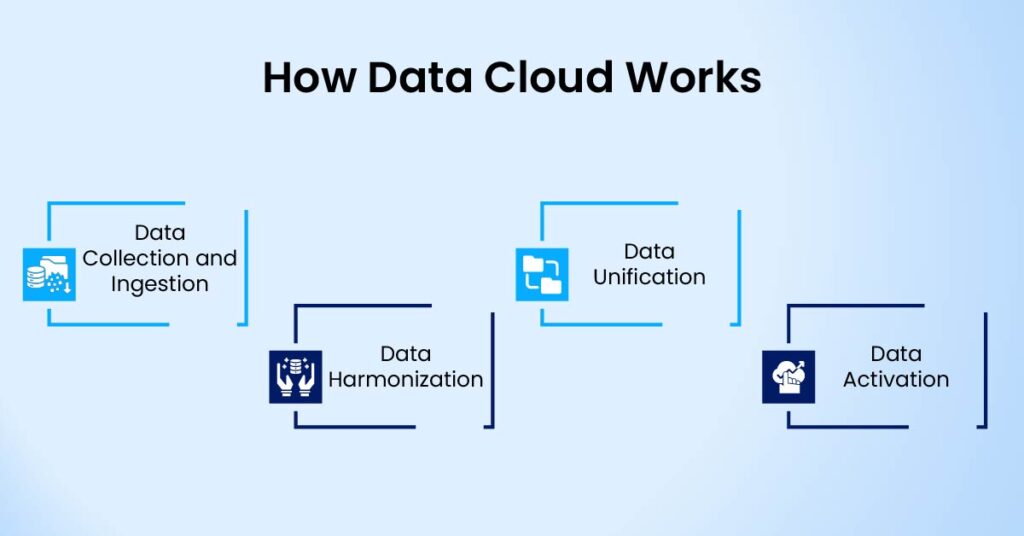Data is the heartbeat of modern businesses, flowing from every customer interaction and accumulating in vast amounts. Whether it’s customer support tickets, purchasing patterns, sales records, email campaigns, or customer touchpoints, the volume of data continues to grow each day. While data is an asset, managing scattered information and extracting real-time insights from data spread across multiple systems and applications can be daunting.
Salesforce Data Cloud provides a solution by centralizing, unifying, and processing real-time data from various sources, enabling businesses to leverage analytics, AI, and automation. 75% of the data in Data Cloud today comes from outside Salesforce. It serves as a single repository for data in any format, allowing business users to analyze and visualize customer information efficiently. One of the standout features of Data Cloud is its ability to handle massive datasets—processing trillions of records with impressive scalability.
For more information on the What, why, and how of Data Cloud, click here.
Originally designed as part of Salesforce’s customer data platform (CDP) for marketing teams, Data Cloud has since expanded its reach to other departments, including sales, service, eCommerce, and beyond.
This blog will explore how Data Cloud works, its benefits for businesses, and how to generate AI-powered insights from data.
How Data Cloud Transforms Data into Actionable Insights
Data Cloud operates by consolidating data from various sources into a single, unified platform. The process involves collecting and ingesting data, harmonizing it into a consistent format, unifying and activating it to provide comprehensive insights through data processing and analysis tools.
Here’s a breakdown of how Data Cloud works:
- Collecting and Ingesting Data
- Harmonizing the Data
- Unifying the Data for a 360-Degree Customer View
- Activating the Data to Understand Customer Behavior

Step 1: Data Collection and Ingestion
Data Cloud collects disconnected data into a single Salesforce platform. This includes both structured and unstructured data from various internal and external sources. The process of data collection and ingestion ensures that all data is stored in one centralized repository for efficient processing and analysis.
Examples of data sources are:
- Salesforce orgs and clouds like Sales Cloud, Service Cloud, Marketing Cloud, Commerce Cloud
- Data Lakes and Data Warehouses
- Third-party sources, including Google Storage Connectors, Amazon S3
- Web and mobile connectors
- Zero-party sources like Snowflake and Databricks
- Unstructured data, including chat transcripts, videos, knowledge base articles
Data collection and Ingestion consolidate all this diverse data into a centralized system, eliminating the need for costly pipelines and enabling seamless integration across platforms.
Step 2: Data Harmonization
Data from various sources often comes in different formats, structures, and quality. During the Data Harmonization step, all ingested data is transformed into a unified model by preparing and cleansing the data. This ensures that the data is normalized and standardized, eliminating inconsistencies. By using a single model, businesses can maintain data consistency and accuracy. Additionally, this model can be leveraged with AI prompts to speed up automation and extract valuable insights from the data.
Examples of different data formats:
- Structured Data: CSV files, Excel spreadsheets, SQL data bases
- Unstructured Data: Text documents, emails and chats, images, audio and video files
- Streaming Data: IoT sensor data, real time feeds, event logs
Step 3: Data Unification
After standardizing the data into a single format, businesses can create a 360-degree view of their customers through Identity Resolution. This process involves unifying customer profiles across multiple data sources, allowing businesses to have a single, comprehensive view of each customer. With Data Mapping, companies can define rules to match and merge different account profiles, ensuring consistency and accuracy. Data Cloud enables businesses to reconcile this information, creating a unified customer profile.
Examples of Data Mapping Rules:
- Combining all records of individuals with the same name and email ID into one profile.
- Merging profiles based on matching phone numbers or addresses across different systems.
- Linking customer profiles with the same social media handles or account IDs from various platforms.
- Unifying profiles that share common loyalty programs or membership IDs across various services.
By applying these data mapping rules, businesses can unify data from various sources for accurate customer profiles that drive better decision-making.
Step 4. Data Activation
Businesses can gain valuable insights by analyzing unified data in the Data Cloud to predict customer behavior. Users can segment customer data and set automated triggers and alerts for specific scenarios. By leveraging Calculated Insights, businesses can create KPIs like Customer Lifetime Value, Engagement Scores, and more. Monitoring the outcomes of data-driven actions allows businesses to refine strategies and boost engagement.
Examples of data activation use cases:
- Marketers can segment audiences based on behavior and purchase history to design highly personalized campaigns.
- Sales teams can use predictive scoring models to prioritize leads and evaluate the probability of conversions, enabling targeted sales efforts.
- Real-time data empowers teams to track KPIs and make continuous improvements by adjusting strategies as needed.
- Finance teams can utilize data to forecast expenses, allocate resources effectively, and enhance operational efficiency.
By implementing data activation strategies, businesses can drive innovation and achieve valuable outcomes.
Benefits of Data Cloud for Business
Data Cloud delivers a unified view of data by centralizing it in one place, making it accessible across departments and business processes to drive real-time insights, scalability, and innovation.
Here are the Key Benefits:
- Breaks down data silos by offering a unified view across teams and departments, streamlining data storage and access for better management.
- Enhances scalability while reducing costs, eliminating the need for costly hardware upgrades.
- Provides real-time insights across business processes, enabling more informed decision-making. Data Cloud also fosters better collaboration, transparency, and streamlined operations.
Salesforce Data Cloud integrates seamlessly with Tableau and Einstein to provide unified, real-time customer data that fuels advanced analytics, personalized insights, and targeted marketing through connected platforms like Marketing Cloud.
How Data from Data Cloud Powers AI-Driven Insights for Enterprises
Data Cloud collects and consolidates data from Salesforce and other enterprise applications, creating a centralized repository for business data. This data can then be used to build low-code AI models that require minimal technical expertise to develop. These AI models analyze the stored data to uncover patterns and trends, using machine learning algorithms to generate powerful, data-driven predictions.
By leveraging AI-powered insights, enterprises can make more informed decisions, automate processes, and predict future trends with greater accuracy—unlocking new opportunities for efficiency, innovation, and growth.
Wrapping Up
Salesforce Data Cloud provides a centralized platform that eliminates data silos and delivers a unified view of customers across systems, departments, and touchpoints. This holistic view empowers enterprises to make informed decisions, enhance customer experiences, and drive operational efficiency.
While implementing Data Cloud may seem complex, AblyPro’s expertise ensures a smooth transition, tailored to your business needs. We specialize in seamless integrations, hassle-free data migration, custom AI model development, and driving effective user adoption.
Contact our experts today to unlock the full potential of Data Cloud and elevate your business to new heights.
Author

AVP, AblyPro

Murali is the AVP – Certinia at AblyPro with 12+ years of experience in handling complex Certinia and Salesforce applications, implementations, configurations, and customizations. At AblyPro, he has been the pillar of all the Certinia PSA and ERP project deliverables, ranging from design to implementation, project management, and resource management. With years of practical knowledge and expertise in this industry, Murali supports the sales team in strategizing customer solutions to meet the actual business needs of the clients. Murali is a dynamic and experienced professional with multiple Certinia and Salesforce certifications, helping businesses to technically strive in this ever-changing landscape.




